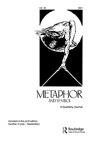Why is Semantic Change Asymmetric? The Role of Concreteness and Word Frequency and Metaphor and Metonymy
IF 3.3
3区 文学
0 LANGUAGE & LINGUISTICS
引用次数: 7
Abstract
ABSTRACT Metaphors and other tropes are commonly thought to reflect asymmetries in concreteness, with concrete sources being used to talk about relatively more abstract targets. Similarly, originating senses in diachronic semantic change have often been argued to be more concrete than extended senses. In this paper, we use a dataset of cross-linguistically attested semantic changes to empirically test the idea that asymmetries in figurative language are predicted by asymmetries in concreteness. We find only weak evidence for the role of concreteness and argue that concreteness is not a helpful notion when it comes to describing changes where both originating and extended senses are highly concrete (e.g., skin > bark, liver > lungs). Moreover, we find that word frequency data from English and other languages is a stronger predictor of these typologically common semantic changes. We discuss the implications of our findings for metaphor theory and theories of semantic change.为什么语义变化是不对称的?具体性、词频、隐喻和转喻的作用
摘要隐喻和其他比喻通常被认为反映了具体性的不对称性,具体来源被用来谈论相对更抽象的目标。同样,历时语义变化中的起源意义通常被认为比延伸意义更具体。在本文中,我们使用一个跨语言证明的语义变化数据集来实证检验比喻语言中的不对称性是由具体性的不对称性预测的。我们只发现了具体性作用的微弱证据,并认为具体性在描述起源感和延伸感都是高度具体的变化时(例如,皮肤>树皮,肝脏>肺部)并不是一个有用的概念。此外,我们发现英语和其他语言的词频数据对这些类型学上常见的语义变化有更强的预测作用。我们讨论了我们的发现对隐喻理论和语义变化理论的启示。
本文章由计算机程序翻译,如有差异,请以英文原文为准。
求助全文
约1分钟内获得全文
求助全文
来源期刊

Metaphor and Symbol
Multiple-
CiteScore
2.90
自引率
0.00%
发文量
23
期刊介绍:
Metaphor and Symbol: A Quarterly Journal is an innovative, multidisciplinary journal dedicated to the study of metaphor and other figurative devices in language (e.g., metonymy, irony) and other expressive forms (e.g., gesture and bodily actions, artworks, music, multimodal media). The journal is interested in original, empirical, and theoretical research that incorporates psychological experimental studies, linguistic and corpus linguistic studies, cross-cultural/linguistic comparisons, computational modeling, philosophical analyzes, and literary/artistic interpretations. A common theme connecting published work in the journal is the examination of the interface of figurative language and expression with cognitive, bodily, and cultural experience; hence, the journal''s international editorial board is composed of scholars and experts in the fields of psychology, linguistics, philosophy, computer science, literature, and media studies.
 求助内容:
求助内容: 应助结果提醒方式:
应助结果提醒方式:


